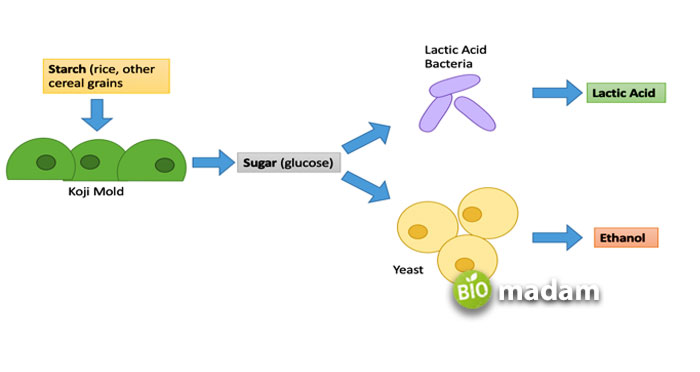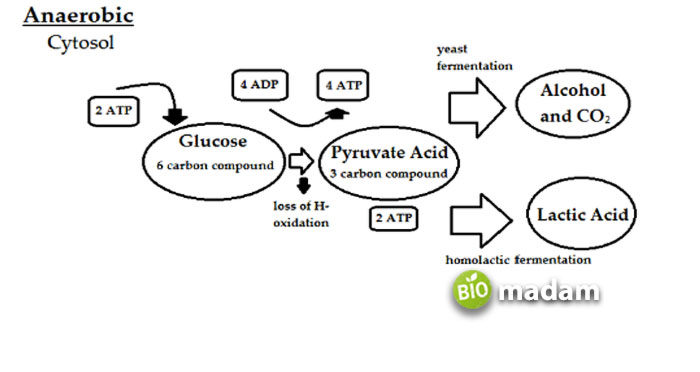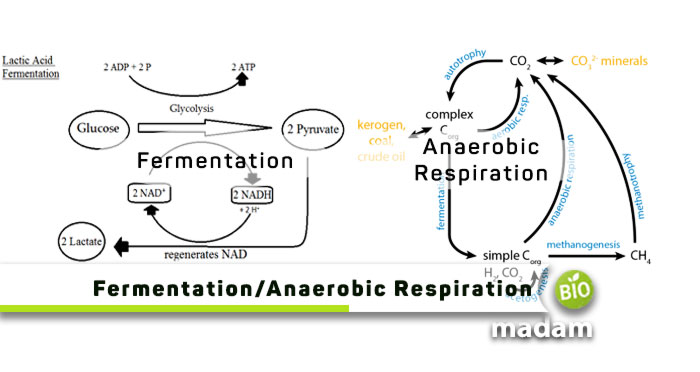Fermentation and anaerobic respiration take place in both eukaryotic and prokaryotic organisms. Despite the occurrence of these processes in all cells, the location and mechanism for both processes is different. Fermentation occurs in the mitochondria while anaerobic respiration takes place in the cytoplasm of the cell. The main difference between fermentation and anaerobic respiration is the absence of Krebs cycle and electron transport chain in fermentation.
Let’s tell you all the differences between fermentation and anaerobic respiration.
Comparison Table
| Characteristics | Fermentation | Anaerobic Respiration |
| Definition | Breakdown of sugars | Respiration without O2 |
| Oxygen Requirement | Low or no | No need |
| Type of Process | In vitro | In vivo |
| Citric Acid Cycle | Absent | Present |
| Electron Transport Chain | Absent | Present |
| ATPs | Four | Thirty eight |
| Energy Produced | Less | More |
| Substrate and Enzymes | Extracellular | Intracellular |
What is Fermentation?
Fermentation refers to a process through which organisms convert starch or sugar to alcohol or an acid without the presence of oxygen.
It is an oxygen-free biological reaction that extracts energy from carbohydrates. The process releases energy through the enzyme-catalyzed metabolic process. Metabolic processes that use an organic molecule as the ultimate electron acceptor, release energy from a sugar or other organic molecule. It does not require oxygen or an electron transport mechanism. The science of fermentation is known as zymology.
Yeast and bacteria use fermentation to create alcohol from sugar to obtain energy. The meanings of fermentation can range from everyday usages to ones that have become more scientific over time.
In general, fermentation refers to utilizing microbes for food preservation. Any massive microbiological process that occurs with or without air is industrial fermentation.
Process of Fermentation
The basic process of fermentation is similar for all molecules and compound apart from the final product. Depending on the kind of fermentation, the final result is a different molecule once the carbohydrate is broken down.
- Glycolysis is the first step in aerobic respiration. It involves the breakdown of carbohydrates like glucose to generate pyruvate molecules.
- The initial step of fermentation is the same as cellular respiration: the production of pyruvic acid by glycolysis, which results in the synthesis of net 2 ATP molecules.
- Furthermore, pyruvate is reduced to produce lactic acid, ethanol, or other compounds.
- NAD+ is generated here and reused in the glycolysis pathway.

Types of Fermentation
Fermentation is of different types based on molecules produced after the breakdown of carbohydrates.
Ethanol Fermentation
The glycolysis-produced pyruvate undergoes two phases of ethanol fermentation before liberating ethanol and carbon dioxide.
Acetaldehyde results when the pyruvate releases carbon dioxide. Acetaldehyde is reduced to ethanol by NADH for the regeneration of NAD+ to use in glycolysis. It results in the production of two molecules of ethanol and two molecules of carbon dioxide from a glucose molecule.
The industrial manufacture of wine, beer, biofuel, etc., uses ethanol fermentation. It’s important to note that fermentation in high pectin levels produces trace amounts of methanol, which is poisonous for consumption.
The process can be indicated through:
C6H12O6 → 2C2H5OH + 2CO2
Lactic Acid Fermentation
It is possible to ferment pyruvate molecules produced during the breakdown of glucose (glycolysis) into lactic acid. The lactate dehydrogenase enzyme drives this process. Through this sort of fermentation, Lactobacillus bacteria produce curd from milk.
The lactic acid bacteria are capable of homolactic fermentation. The final result is primarily lactic acid, or heterotactic fermentation. Lactate produces ethanol, carbon dioxide (through the phosphoketolase pathway), acetate, or other metabolic products.
The following equation describes how glucose has lactic acid.
Glucose (C6H12O6) = CH3CHOHCOOH (lactic acid)
It is possible to sum up how lactose and water yield lactic acid as follows:
Lactose (C12H22O11) + water (H2O) = 4CH3CHOHCOOH (lactic acid).
It also happens in animal muscles when tissues need energy more quickly. This type of fermentation can deliver oxygen to muscles faster.
Acetic Acid Fermentation
This type of fermentation results in vinegar. There are two steps to this. The first stage involves utilizing yeast to produce ethyl alcohol from sugar anaerobically. Ethyl alcohol and acetobacter bacteria oxidize to produce acetic acid in the second stage. Alcohol undergoes aerobic microbial oxidation to produce acid.
Ethanol + oxygen = acetic acid + water
Hydrogen and Methane Gas Fermentation
Methanogenic archaea are a type of archaebacteria that produce methane and carbon dioxide gas. They do so by transferring one electron from a carbonyl of a carboxylic acid group to a methyl group of acetic acid in a disproportionation reaction.
Numerous fermentation processes produce hydrogen gas as a means of regeneration of NAD+ from NADH. Ferredoxin receives an electron transfer, and hydrogenase then oxidizes it to produce H2. Methanogens and sulfate reducers use hydrogen gas as a substrate to keep hydrogen concentration low and promote the creation of such an energy-rich compound. Yet, hydrogen gas can still occur at relatively high concentrations, as in flatus.
In the case of glucose fermentation, Clostridium pasteurianum produces butyrate, acetate, carbon dioxide, and hydrogen gas. The following reaction produces acetate:
C6H12O6 + 4H2O → 2CH3COO− + 2HCO3− + 4H+ + 4H2
Advantages of Fermentation
Fermentation is essential to life for prokaryotic and eukaryotic organisms and has numerous industrial uses. All kinds of conditions are conducive to fermentation. Prokaryotes and eukaryotes both share one of the earliest metabolic pathways.
Fermentation produces different products using suitable microorganisms under the right conditions, including biofuel, wine, pickles, yogurt, bread, antibiotics, analgesics, certain vitamins and helps in improving mineral bioavailability.
Cells of human muscle perform fermentation. They provide oxygen to muscles faster. Glycolysis, which in this instance doesn’t require oxygen, generates ATP.
It enhances digestion and maintains gut flora.
Fermentation has a cancer-preventing action.
Increases immunity and brings down lactose intolerance.
Food can become nutrient-rich, digestible, and flavorful by fermentation. Consuming fermented food has a variety of advantages.
Human digestive tract fermentation results in ethanol generation, which causes intoxication in a rare medical disorder, also called a disease, known as gut fermentation syndrome.
What is Anaerobic Respiration?
Both eukaryotes and prokaryotes perform anaerobic (cellular) respiration, a type of respiration in which cells use sugar molecules as a source of energy without using oxygen. However, some anaerobic respiration processes require the electron transport chain system to transfer electrons to the ultimate electron acceptor, whereas fermentation simply includes the glycolysis phase.
Process of Anaerobic Respiration
The anaerobic respiration process, which includes glycolysis and fermentation, occurs in the cytosol of the cytoplasm. In contrast, most aerobic respiration energy production occurs in the mitochondria.
The process of anaerobic respiration has two steps.
- Glycolysis
- Fermentation
The breakdown of a glucose molecule into two pyruvate molecules is the first step in anaerobic respiration. It releases electrons in the process and creates two ATP molecules, the energy source for cells. When oxygen is available, some pyruvate molecules undergo two processes that liberate extra electrons, which are then used to power a significant quantity of ATP generation. Pyruvate undergoes a separate byproduct conversion, and carbon dioxide is also emitted. This process produces two ATP molecules.
In other cases, the cell switches to a different mode of respiration where, despite the lack of oxygen, a specific pathway leads to using an electron transport chain, which passes the electrons to an organic or inorganic electron acceptor.

Types of Anaerobic Respiration
It occurs in various ways depending on the electron acceptors. Important anaerobic respiration types include
Lactic Acid Fermentation
In this type of anaerobic respiration, glucose is divided into two molecules of lactic acid to create two ATP. Certain bacteria and some animal tissues, such as muscle cells, exhibit it.
Lactic acid fermentation equation:
C6H12O6 (glucose) + 2ADP + 2pis → 2CH3CHOHCOOH + 2ATP
Alcoholic Fermentation
It is a form of anaerobic respiration in which glucose breaks down to produce ethanol or ethyl alcohol. Each sugar molecule yields two ATP as a result of this mechanism. This fermentation also happens in a few fish, such as goldfish and yeast.
The equation for alcoholic fermentation:
C6H12O6 (glucose) + 2ADP + 2pi → 2C2H5OH (ethanol) + 2CO2 + 2ATP
Other Fermentations
There are several types of fermentations that bacteria and archaea are capable of performing. Among these are acetogenesis, methanogenesis, propionic acid fermentation, butyric acid fermentation, solvent fermentation, mixed acid fermentation, butanediol fermentation, and Stickland fermentation.
Advantages of Anaerobic Respiration
Microbial fuel cells use anaerobic respiration to produce electricity.
Waste management systems and sewage treatment facilities both use anaerobic respiration. The denitrification stage in the sewage treatment process removes nitrate. In bioremediation techniques, pollutants such as petroleum, arsenic, radioactive, and chlorinated compounds are reduced anaerobically.
The anaerobic respiration industry’s most prevalent use is alcohol fermentation. The manufacture of alcoholic beverages (beer, wine, distilled alcohol, etc.) has a long history and continues to be a significant industry.
Production of organic acids for industrial and domestic usage, including butyric acid, lactic acid, and propionic acid.
Anaerobic respiration is crucial to functioning biogeochemical cycles such as carbon, nitrogen, iron, and sulfur.
Similarities between Fermentation and Anaerobic Respiration
- Anaerobic respiration and fermentation involve various enzymes.
- Inorganic phosphates speed up the pace at which anaerobic respiration and fermentation break down sugar.
- Both processes take place to generate energy in the absence of oxygen.
- Hexose sugars serve as the respiratory substrate for fermentation and anaerobic respiration.
- Glycolysis occurs during both anaerobic respiration and fermentation.
Difference between Fermentation and Anaerobic Respiration
Definition
Fermentation
Fermentation refers to a particular metabolic process that converts sugars into ethanol and carbon dioxide.
Anaerobic Respiration
It is a form of cellular respiration in which the disintegration of sugar molecules produces energy without oxygen.
Presence of Oxygen
Fermentation
It may take place under low oxygen or no oxygen.
Anaerobic Respiration
Simultaneously, aerobic respiration does not require any oxygen at all.
Type of Process
Fermentation
Fermentation is an in vitro process.
Anaerobic Respiration
At the same time, anaerobic respiration is an in vivo process.
Proceedings
Fermentation
In fermentation, glycolysis does not follow the citric acid cycle and electron transport chain.
Anaerobic Respiration
Whereas anaerobic respiration starts with the citric acid cycle and the electron transport chain.
Energy Production
Fermentation
Fermentation produces four ATP in total.
Anaerobic Respiration
At the same time, glycolysis, citric acid cycle, and electron transport chain all contribute to the production of 38 ATP molecules, leading to a higher energy.
Occurrence
Fermentation
Fermentation takes place in bacteria, yeast, molds, or some fungal bodies, besides other microbes.
Anaerobic Respiration
Human cells, yeast, and bacterial cells that breathe without oxygen all exhibit it.
Substrate and Enzymes
Fermentation
Substrates and enzymes are extracellular in fermentation.
Anaerobic Respiration
Conversely, anaerobic respiration has intracellular enzymes and substrates.
The Bottom Line
Often, fermentation and cellular respiration (aerobic and anaerobic) are considered synonymous. Yet, they are not entirely the same. Both can take place in the absence of oxygen. However, the main difference between fermentation and anaerobic respiration is the absence of Krebs cycle and electron transport chain in fermentation. Eventually, anaerobic respiration produces more energy than fermentation. Fermentation takes place in human beings, yeast, and molds while bacterial cells and many other living organisms exhibit anaerobic respiration.

Hello, I would like to introduce myself to you! I am Chelsea Rogers, an experienced blog writer for science articles, holding an MPhil degree. My enthusiasm to grab the best knowledge, let it relate to botany, zoology, or any other science branch. Read my articles & let me wait for your words s in the comment section.

